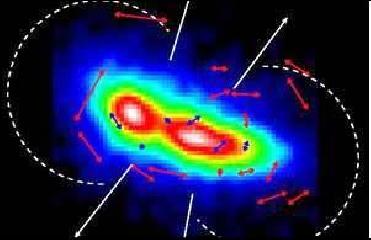
White dotted line showing how a magnetic bubble cocoons the galaxy
LONDON (BNS): Researchers have invented 'magnetic bubble' shield that will protect astronauts from harmful radiation on the future missions to Mars and other planets.
Scientists at the Science and Technology Facilities Council (STFC), the Universities of York and Strathclyde, and the IST Lisbon have discovered that astronauts could protect themselves with a new 'force field' technology on their journey to the nearest neighbours.
According to the international space agencies, "Space Weather" is the single greatest obstacle to deep space travel. Radiation from the sun and cosmic rays pose a deadly threat to astronauts in space.
Thanks to painstaking research of five decades, researchers have said that a giant 'magnetic bubble' could serve as a protection shield for astronauts and their spacecrafts from harmful effect of radiation from solar storms.
The finding of the researchers has been published in the November 4 issue of the Institute of Physics (IOP) Publishing's Plasma Physics and Controlled Fusion. The researchers have noted that the shield would be similar to the Earth's own magnetosphere which protects humans from the deadly radiation of cosmic rays - energetic particles originating from the Sun and elsewhere in space.
The idea for these shields had been around since the 1960s but it was thought impractical because it was believed that only a very large (> 100km wide) 'magnetic bubble' could possibly work.
Researchers in Lisbon, working with scientists at STFC's Rutherford Appleton Laboratory, on computer simulations had arrived at a decision that a very much smaller 'magnetic bubble' of only several hundred meters across would be enough to protect a spacecraft. They said it would scatter the highly charged, ionised particles of solar wind and solar flares and allow astronauts to travel further in space without the threat of deadly radiation sickness.
Explaining the magnetic bubble shield technology, the researchers using apparatus originally built to work on nuclear fusion, recreated a tiny piece of Solar Wind in a 'bottle'. The scientists then confirmed that a small 'hole' in the Solar Wind is all that would be needed to keep the astronauts safe on their journey to the nearest neighbours.
Dr Ruth Bamford, one of the lead researchers at the Rutherford Appleton Laboratory, said, "These initial experiments have shown promise and that it may be possible to shield astronauts from deadly space weather."
The Apollo astronauts of the 1960's and 70's are the only humans who walked on the Moon, beyond the Earth's natural 'force field' � the Earth's magnetosphere. With journeys to the Moon lasting about eight days, the Apollo astronauts were lucky not to have faced problems from the Sun that would have flooded their spacecraft with deadly radiation. A journey to Mars, however, would take about 18 months, during which time it is almost certain that astronauts would be enveloped by such a storm.
Spacecraft visiting the Moon or Mars could maintain some of this protection by taking along their very own portable "mini"-magnetosphere.
 Previous Article
Previous Article













The Indian Air Force, in its flight trials evaluation report submitted before the Defence Ministry l..
view articleAn insight into the Medium Multi-Role Combat Aircraft competition...
view articleSky enthusiasts can now spot the International Space Station (ISS) commanded by Indian-American astr..
view article